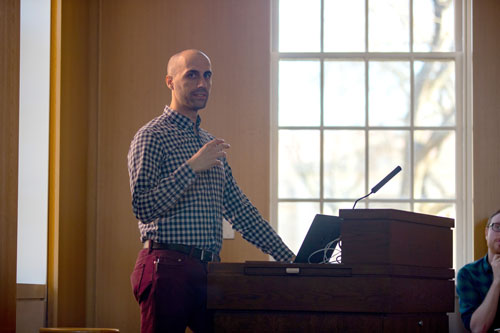Digitizing history
According to Marko, work on the database began after Giles Eyre, a local history enthusiast and volunteer with the Historic Cemetery Advisory Commission, reached out to him for recommendations on people or groups who could assist in mapping the location of the grave markers in God’s Little Acre. Eyre knew of Marko from previous work unearthing turn-of-the-century history in Rhode Island: In Fall 2019, Marko taught a Brown course called Archaeology of College Hill, where he supervised an ongoing excavation of a Gilded Age house in Providence.
“Immediately, I knew it was something interesting and important to do, because of the nature of the cemetery and the stories that could be told there,” Marko said of Eyre’s proposed project. “And I knew it was something we could easily do ourselves.”
The students had their work cut out for them. While several stories of the people buried on the site do endure, and some are even shared on walking tours or on museum signage, others remain unknown or are not publicly accessible. Slaves’ names, ages and residences were not included in censuses in Newport’s early history. Africans and African Americans were less likely to have learned to read or write, Marko said, so very few of their personal stories remain today. Even information about God’s Little Acre itself is lacking — the only known map of the cemetery is from 1903, and it is likely missing hundreds of names of those who had been interred in the two centuries before. A map of the original 1700s plot, if it ever existed, is now long gone.
“There is no surviving legacy map of the cemetery,” Marko said. “We are documenting everything in order to abate loss at this point.”
With help from the 1903 map, information provided by Eyre, and history that had been unearthed by Keith Stokes, a local scholar and descendant of some of the individuals buried at God’s Little Acre who maintains a website for the cemetery, the students were able to visit every known grave marker and record as much information as possible: names, birth and death years, relatives, epitaphs and occupations, as well as gravestones’ materials, shapes, thicknesses and conditions. At several markers, they took dozens of photos at every angle and stitched them together to create interactive three-dimensional models. And they flew a drone over the entire area to capture aerial video and photos, which allowed them to create a master map of the cemetery and develop graphics that documented its growth and evolution over the years.
Today, all the facts and visuals they collected live on a single interactive platform that they hope to share widely, so that everyone in the community can engage with this important history.
“We had access to a lot of the information about the people buried here, but we had no spatial data,” Rothenberg said — in other words, they knew the names of many who were buried at God’s Little Acre, but they didn’t know exactly where each of them was buried. “We’re linking an existing database with what’s on the ground and adding data we come across, so that someday, people can use a map on their phone or tablet to identify specific graves and interact with this site and its history more personally.”
All three researchers felt adamant about hosting the database on a free, open-access platform so that there was no barrier to access.
“We could do more with paid software, but that goes against the ethos of the project, which was community-focused from the beginning,” Plekhov said. “It’s a living product that people can access and engage with and build on.”
